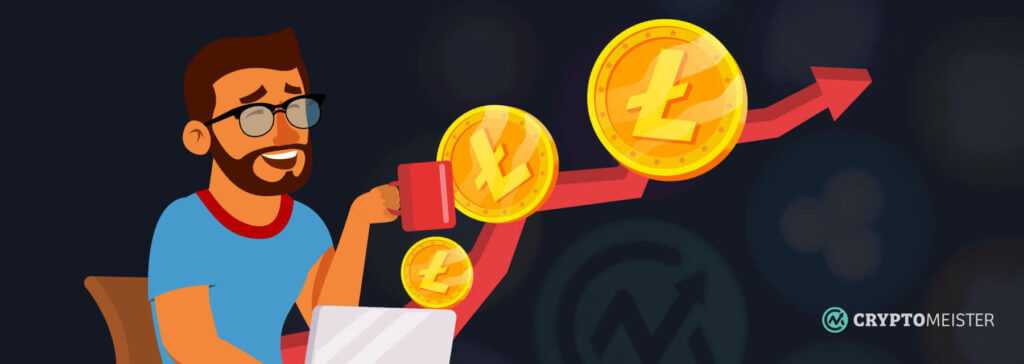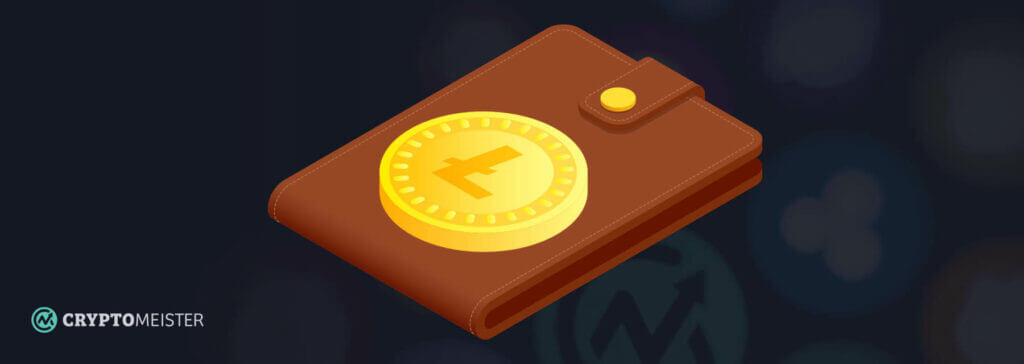
Binance
Only for verified users
Litecoin is a cryptocurrency created to serve as an alternative to Bitcoin, you enjoy faster transaction speeds and lower fees than Bitcoin’s network. By the end of this article, you will understand how Litecoin works, how to buy Litecoin, and where to buy Litecoin.

Only for verified users



Litecoin (LTC) is a cryptocurrency created from a fork of the Bitcoin blockchain in 2011.
It was created to serve as an alternative to Bitcoin, addressing mining centralization concerns in Bitcoin and slow transaction processing speeds.
Litecoin was also designed to serve primarily as a payment method for everyday transactions at a time when concerns over Bitcoin’s ability to function as a currency were starting to be voiced.
Litecoin was created by Charlie Lee, a former Google engineer. As part of the creation process, Lee developed a new hashing algorithm for Litecoin called Scrypt. Scrypt is an algorithm designed to facilitate faster transaction speeds for Litecoin.
Unlike Bitcoin, which can only process about five transactions per second, Litecoin can process as many as 54 transactions per second and produce a new block every 2.5 minutes, as opposed to Bitcoin’s 10-minute timeframe.
Litecoin soon became accepted in many of the same places Bitcoin was, with people preferring to buy Litecoin for use as a medium of exchange due to its faster speeds and lower costs, and this is often still the case.
Given that it is a fork of Bitcoin, Litecoin shares many similarities with its older brother, including the same proof-of-work consensus mechanism. One major difference was the introduction of the different mining algorithm which increased the transaction speed and made the network more secure, while developers also tried to ensure that anyone with a computer could mine Litecoin from home, which for the first few years they could.
The function of the proof-of-work consensus mechanism is to verify the authenticity of a transaction and add the next batch to the blockchain.
In 2022 Litecoin undertook its biggest upgrade in many years by implementing the MimbleWimble Extension Block (MWEB). This scaling solution anonymizes transaction information like the sender’s address, receiver’s address, and the amount transferred to offer complete privacy.
On top of this, MWEB removes any unnecessary transaction data to make blocks more compact and scalable.
Litecoin has a maximum coin supply of 84 million coins, four times as many as Bitcoin. Like Bitcoin it employs a mechanism called a ‘halving’ which halves the amount of LTC awarded to miners on adding a block.
The halving occurs every 840,000 blocks recorded on the blockchain and is intended to maintain the value of the coin by reducing the supply. Currently, miners are rewarded with 12.5 LTCs, but this will halve to 6.25 around August 2023.
You can buy Litecoin on multiple cryptocurrency exchanges, which vary by structure and the jurisdiction they can operate in, but with it still being one of the ‘old guard’ the chances are good you can buy Litecoin in your country.
You cannot buy Litecoin on decentralized exchanges, meaning that your only way of purchasing it is through a centralized exchange. Centralized exchanges are controlled by a single entity – the organization that developed the exchange – and require you to register with a government-approved ID before accessing features that allow you to buy Litecoin.
They are also known to place freezes on accounts at the behest of government agencies, so Litecoin’s freedom from censorship feature will not apply on a centralized exchange.
Some of the most popular exchanges that allow you to buy Litecoin are as follows (bear in mind they each have a slightly different purchasing process):
There are a few ways you can pay for Litecoin, but we’ll cover the most common (and convenient) here:
Credit card/debit card
Many exchanges allow users to buy Litecoin with a credit card or debit card, again providing your bank supports crypto purchases. A transaction can be initiated quickly once a card is connected to the account and the details can be stored should you decide to buy Litecoin again afterwards.
Bank transfer
Bank transfers are a little more complicated than choosing to buy Litecoin with a credit card or debit card, but they are a workaround for banks that don’t allow card purchases. The process involves manually sending the funds over to the exchange, and perhaps getting the details confirmed first with a test purchase of, say $1.
Once your account has been connected you can then top up your fiat account from your bank account, often from within your account. You can also withdraw funds back to this account again.
Paypal
Paypal announced that users can buy Litecoin, sell, and spend it when it launched its crypto platform last year. Obviously you need a Paypal account first, but once you do it’s a simple process to buy Litecoin on the Paypal Crypto platform.
You can either use funds already in your Paypal account to buy LTC, which is quicker, or you can buy Litecoin with a credit card or debit card linked to your account.

Litecoin has a number of functions and uses thanks to its combination of blockchain security and fast transitions, relative to Bitcoin.
Cheap and efficient fund transfers
Since Litecoin’s primary purpose is to facilitate cheaper and faster payments, many people buy Litecoin to use it for sending and receiving funds. An excellent example of this is a Litecoin transaction worth $99 million that took place on April 19,2018. The processing time for the transaction was just two and a half minutes, and it was done at the cost of just $0.40. Such a feat is unattainable in traditional finance.
Shopping
Merchants that accept cryptocurrencies typically accept Litecoin given its popularity, including any retailers that accept PayPal. This means those who buy Litecoin also have access to thousands of retailers worldwide, with companies such as Bitrefill also allowing the purchase of gift cards with LTC.
Anonymity
Holders who buy Litecoin can carry out transactions privately. However, privacy doesn’t always imply secrecy. The transaction will still be publicly recorded on the blockchain, but you don’t need to personally identify yourself. With the launch of the MWEB protocol, you can now enjoy 100% privacy. Exciting!
Earn Through DeFi
People buy Litecoin because it is a better alternative to investment vehicles offered in traditional finance because Litecoin investments provide much higher returns. Some platforms offer as much as 12% per annum, which is significantly more than the 1-year Treasury rate of 2.92% and savings account interest rate of 0.06%.
Avoid Censorship
While your bank account can be frozen at any time by a financial institution or based on a request from a government agency, if you buy Litecoin and store it in a decentralized wallet you can avoid similar restrictions. As long as the account holder has their private keys they can access their holdings anywhere and anytime.
Gaming
People also buy Litecoin because it is a popular coin for online gambling, with various platforms allowing users to bet on sports and casino games like slots, video poker, live dealer, baccarat, roulette, craps, and blackjack in LTC.

In simple terms, a Litecoin wallet has the same function as the wallet in your pocket – the goal is to store your valuables safely. Litecoin wallets come in two primary forms:
A Litecoin wallet will have three elements to it, which it is important to know:
Some wallets allow the holder to keep the private key for themselves, meaning that they have full control over their funds. Others retain the public key on their own servers which presents certain security concerns although typically allows quicker access.
Some good wallets on which to store your Litecoin are TrustWallet, Exodus, Trezor and Ledger. if you want to run a Litecoin node yourself you can download the Litecoin Client (and blockchain) which contains a wallet.
The goal of a Litecoin transaction is to transfer a specified amount of LTC from one account to another as fast as the blockchain will allow. As stated earlier in this article, Litecoin offers significantly faster processing speeds and cheaper fees than its counterpart, Bitcoin.
There are several reasons Litecoin transactions are so efficient and cheap, the most prominent one being that Litecoin has incorporated specific protocols that make its network more efficient. In addition, it doesn’t have the same congestion level as other networks like Bitcoin and Ethereum.
When a Litecoin transaction is submitted, it is bundled into a block containing all other transactions submitted within a 2.5 minute window and allocated to a miner to verify and authenticate. Once authenticated, the transactions are confirmed by a network of nodes and the funds are sent to the recipient.
Historical records show that the typical transfer fees for Litecoin are between $0.0195 and $0.0942 during peak times. At the same time, transaction approval times are usually between 2.32 minutes to 2.81 minutes per block.
Litecoin transfers that require just one confirmation are typically processed in under three minutes, while Litecoin transfers that require three confirmations generally are processed in under nine minutes.
If you decide to buy Litecoin, you can track transactions using Litecoin block explorers like BlockCypher, BlockChair and Chainz.

There are certain things you should consider before you buy Litecoin, which we will list here:
Is Litecoin legal?
There is no simple answer to the question of the legality of Litecoin as countries have adopted different approaches to cryptocurrency in general. According to the US Library of Congress, nine jurisdictions have placed an absolute ban on cryptocurrencies, while 42 have placed an implicit ban on using cryptocurrencies.
This leaves 144 countries that have yet to take a position on crypto. However, the following countries recognize cryptocurrencies as a financial asset:
Until 2022 Litecoin had never been singled out as a currency of concern to individual nations, meaning that the general rules of cryptocurrency applied to it.
This changed with the implementation of MWEB however which led to all South Korean exchanges being forced to delist it because the increased privacy contravened the country’s laws on privacy coins.
Litecoin is in a difficult situation when it comes to its future. The protocol has been around for over a decade and hasn’t really changed much from its inception. When it launched it was the perfect antidote to Bitcoin’s slow blockchain, hence why it was referred to as the silver to Bitcoin’s gold, but time has brought with it developments that have seen Litecoin fall down the pecking order.
Litecoin is a bit like an aging sports star – remembered by those who were around when it was at its peak but meaningless to newer generations of fans. It has tried to stay relevant by implementing MWEB, but in many ways this has caused more damage than good, at least initially.
Litecoin also faces pressure over its use of the proof-of-work consensus mechanism which is facing calls to be outlawed. Like Bitcoin it has never hinted adopting a fallback like proof-of-stake, raising uncomfortable questions over this part of its future.
All this being said, Litecoin has survived two bear markets and is still in the top 20. It was one of the five coins Paypal launched with in 2021 and, truth be told, there aren’t that many payment coins that can combine its speed, low cost and levels of adoption. Like a good zombie, it just refuses to die.
Despite its poor performance in recent years, Litecoin is still among the top 20 cryptocurrencies globally…just! This is a remarkable feat given that over 10,000 cryptocurrencies have been launched, showing that Litecoin still enjoys high visibility and high desirability, however outdated it might appear.
Litecoin is one of the oldest cryptocurrencies in the space, and it has been around long enough for investors to trust its reliability and security where other newer blockchains can’t seem to operate when Amazon Web Services goes down. Its transaction processing speed and low fees continue to be essential features, with many still choosing to use it over newer, more agile blockchains.
Whether or not you should buy Litecoin as an investment depends on your view of its future – can it continue to fend off these faster, more agile upstarts and be the Gandalf of payment coins, or will its lack of development and gas guzzling consensus mechanism see it pay the ultimate price?